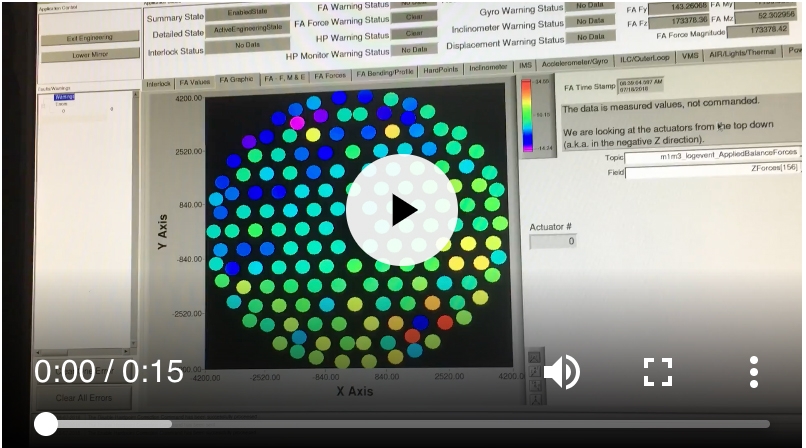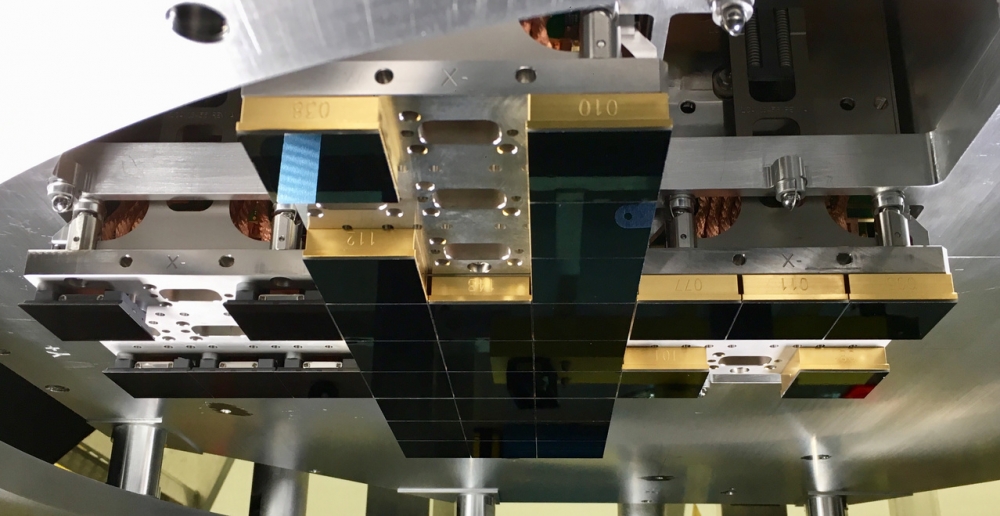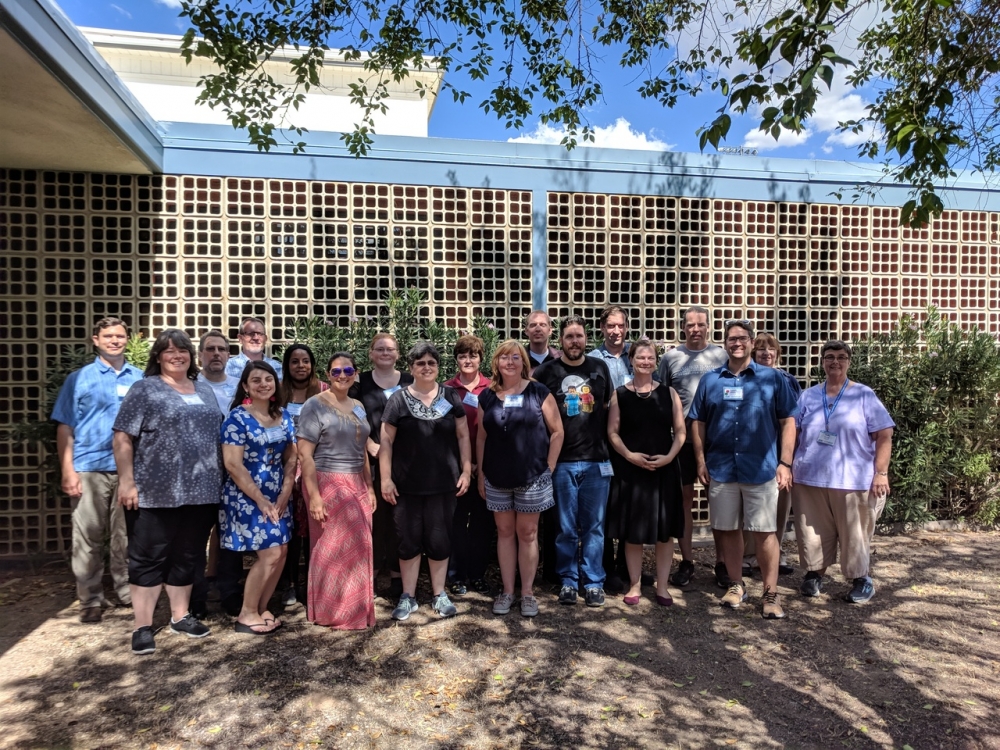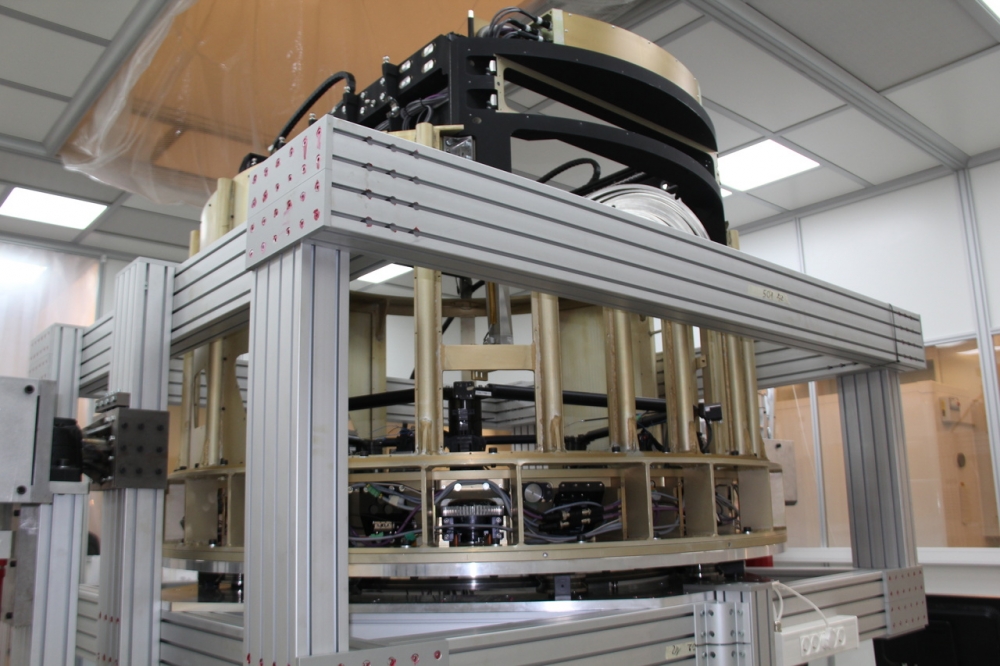The LSST 2018 Project and Community Workshop is currently underway in Tucson, AZ, with over 300 people registered. The meeting concludes on August 17.
Please note that Summer Daylight Saving Time began in Chile on August 11, on that day clocks in Chile advanced by one hour.
The Call for White Papers on LSST Cadence Optimization continues, submittals must be received by November 30, 2018.
The NSF/DOE Joint Status Review for LSST took place from July 31-August 3 in Tucson, AZ. Plenary presentations and breakout sessions for all LSST subsystems were scheduled for the first four days. On the final day, the review committee issued its recommendations and congratulated the Project team on its excellent progress to date.
The Coating Chamber departed Deggendorf, Germany on a covered river barge headed to Antwerp, Belgium, with a planned arrival date of August 13. It is scheduled to begin its journey by ship to Chile from Belgium on August 30.
The Camera team has accepted an additional raft comprised of UA Imaging Technology Laboratory (ITL) sensors, and an additional raft with Teledyne e2v sensors. This makes a total of twelve rafts--over 1.6 gigapixels--now ready for integration into the cryostat. Six more ITL sensor rafts and four more e2v sensor rafts are scheduled to be completed at Brookhaven National Labs by January 2019.
The Integration and Test (I&T) group at SLAC National Accelerator Laboratory has integrated a mechanical test raft (MTR) within the production cryostat assembly that is now installed in the Bench for Optical Testing (BOT). Over the next few months, I&T will do integration exercises using the five MTRs and two engineering test rafts (ETUs). The exercises lead the way to integration of production rafts within the cryostat, currently expected to begin in early 2019. More information about the raft integration process can be found in this recent news item.
The Camera team has demonstrated a prototype shutter at SLAC that opens and closes test shutter blades at acceptable speeds. The test blades are heavier than production blades, which are under construction at San Diego Composites. On the Camera, the double-bladed guillotine-style mechanical shutter will lie tightly packaged between the L3 lens and the on-line lens filter.
LSST CORPORATION NEWS
The LSSTC Data Science Fellowship Program (DSFP) is now accepting applications for new students. The DSFP is a supplement to graduate education in astronomy, intended to teach astronomy students essential skills for dealing with big data. The program consists of three, one-week schools per year over a two-year period. Click here for more information and a link to the application; apply by August 22.
PERSONNEL NEWS
Carol Chirino has been promoted to Administrative Manager for LSST in Chile. In this role, Carol will be responsible for overseeing the functionality of all LSST’s outside-the-dome infrastructure for the benefit of LSST’s operations and people, and for the delivery of high quality administrative services to the LSST staff and user community.
Julio Constanzo joined LSST as IT User Support Help Desk Engineer in La Serena, Chile, on August 1. Julio will serve as the first point of contact for LSST users in Chile seeking technical assistance through JIRA, phone, or email.
Dr. Timothy S. Axelrod re-joined the Project as a Consultant on July 23. Tim will be assisting the Telescope & Site Software Team to address challenges in completing the construction and integration of the LSST observatory and preparing it for commissioning. Tim has been involved in LSST since 2005 in various positions such as Education and Public Outreach Project Scientist, Data Management Project Scientist, and LSST Calibration Science Lead.
UPCOMING MEETINGS with LSST INVOLVEMENT
(those with asterisk* are LSSTC funded):
2018 | |
August 13-17 | LSST Project and Community Workshop 2018, Tucson, AZ |
September 5-6 | AMCL Meeting, SLAC, CA |
September 17-19 | LSST Cadence Hackathon, Flatiron Institute, NY |
September 27-28 | LSST Corporation Executive Board Retreat, Tucson, AZ* |
October 21-26 | AAS Division of Planetary Sciences (DPS) 50th Annual Meeting, Knoxville, TN |
October 22-26 | LSST-DESC Autumn Sprint Week, Edinburgh, Scotland* |
October 24-25 | LSST Corporation Institutional & Executive Board Meeting, Tucson, AZ* |
December 17-21 | South American Workshop on Cosmology in the LSST Era, Sao Paulo, Brazil |
2019 | |
January 6-10 | AAS 233rd Meeting, Seattle, WA |
NOTICIAS DEL PROYECTO & CIENTIFICAS
LSST 2018 El taller del Proyecto y Comunitario está actualmente en marcha en Tucson, AZ, con sobre 300 personas registradas. La junta concluye este viernes 17 de agosto.
Tener en cuenta que el horario de verano comenzó en Chile el 11 de agosto, ese día los relojes en Chile se adelantaban en una hora.
La convocatoria de propuestas para la optimización de la cadencia LSST continua, las inscripciones deben ser recibidas para el 30 de Noviembre 2018.
La junta de revisión de status de NSF/DOE tomo lugar desde el 31 de Julio al 3 de Agosto en Tucson, AZ. Las presentaciones plenarias y las sesiones de trabajo para todos los subsistemas del LSST se programaron para los primeros cuatro días. El último día, el comité de revisión emitió sus recomendaciones y felicitó al equipo del Proyecto por su excelente progreso a la fecha.
La Cámara de Recubrimiento partió de Deggendorf, Alemania, en una barcaza fluvial cubierta que se dirigía a Amberes, Bélgica, con una fecha de llegada prevista para el 13 de agosto.
Está programado que comience su viaje en barco a Chile desde Bélgica el 30 de agosto.
EL equipo de la cámara ha aceptado una plataforma adicional compuesta de sensores del UA laboratorio de tecnología de imagen (ITL), y además una plataforma con Teledyne e2v sensores. Esto hace un total de 12 plataformas --sobre 1.6 gigapixeles-- ahora listo para la integración en el criostato. Seis plataformas de sensores ITL mas y cuatro plataformas de sensores e2v están programadas para completar el Brookhaven National Labs para Enero del 2019.
El grupo de integración y prueba (I&T) en el SLAC National Accelerator Laboratory ha integrado una plataforma de prueba mecánica (MTR) dentro del ensamblaje criostato de producción que ahora está instalado en el banco para pruebas ópticas (BOT). En los próximos meses, I & T realizará ejercicios de integración utilizando los cinco MTR y dos plataformas de prueba de ingeniería (ETUs). Los ejercicios conducen a la integración de plataformas de producción dentro del criostato, que se espera que comience a principios de 2019. Se puede encontrar más información sobre el proceso de integración de plataforma en esta noticia reciente.
El equipo de la cámara ha demostrado un prototipo de obturador en SLAC que abre y cierra las hojas del obturador de prueba a velocidades aceptables. Los blades de prueba son más pesados que los blades de producción, están en construcción en San Diego Composites. En la cámara, el obturador mecánico de estilo guillotina de doble hoja se colocará bien empaquetado entre la lente L3 y el filtro de lente en línea.
LSST NOTICIAS CORPORATIVAS
El programa de becas LSSTC Data Science (DSFP) está aceptando solicitudes para nuevos estudiantes. El DSFP es un complemento de la educación de postgrado en astronomía, con la intención de enseñar a los estudiantes de astronomía las habilidades esenciales para manejar grandes cantidades de datos. El programa consta de tres escuelas de una semana por año durante un período de dos años. Haga clic aquí para obtener más información y encontrara un enlace a la aplicación; postular antes del 22 de agosto.
NOTICIAS DEL PERSONAL
Carol ha sido promovida a Gerente Administrativo de LSST en Chile. En esta función, Carol será responsable de supervisar la funcionalidad de toda la infraestructura de LSST fuera del domo en beneficio de las operaciones y personas de LSST, y para la entrega de servicios administrativos de alta calidad al personal y la comunidad de usuarios de LSST.
Julio Constanzo se unió a LSST el 1 de agosto como técnico de soporte de TI en La Serena, Chile. Julio servirá como el primer punto de contacto para los usuarios de LSST en Chile que buscan asistencia técnica a través de JIRA, teléfono o correo electrónico.
El Dr. Timothy S. Axelrod se reincorporó al Proyecto como Consultor el 23 de julio. Tim asistirá al Telescopio y al Equipo de Software del Sitio para abordar los desafíos para completar la construcción e integración del observatorio LSST y prepararlo para la puesta en servicio. Tim ha estado involucrado en LSST desde 2005 en diversos puestos, tales como el científico del proyecto de divulgación pública y de educación, el científico del proyecto de gestión de datos y el líder de ciencia de calibración LSST.
PRÓXIMAS REUNIONES con LA PARTICIPACIÓN DE LSST
(aquellas con asterisco * son financiados por LSSTC):
2018 | |
13-17 Agosto | Proyecto LSST y taller comunitario 2018, Tucson, AZ, |
5-6 Septiembre | AMCL Meeting, SLAC, CA |
17-19 Septiembre | LSST Cadence Hackathon, Flatiron Institute, NY |
27-28 Septiembre | Retiro de la Junta Corporativa Ejecutiva de LSST, Tucson, AZ * |
21-26 Octubre | División AAS de Ciencias Planetarias (DPS) 50th Annual Meeting, Knoxville, TN |
22-26 Octubre | LSST-DESC Autumn Sprint Week, Edinburgh, Escocia* |
24-25 Octubre | LSST Corporation Institutional & Executive Board Meeting, Tucson, AZ* |
17-21 Diciembre | South American Workshop on Cosmology in the LSST Era, Sao Paulo, Brazil |
2019 | |
6-10 Enero | AAS 233 reunion, Seattle, WA |









